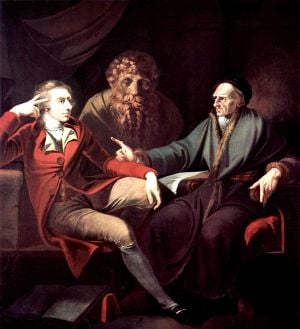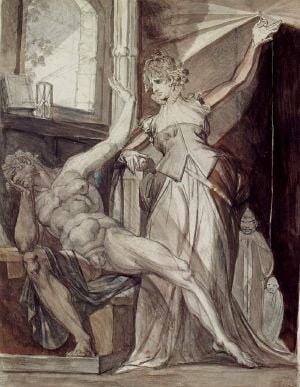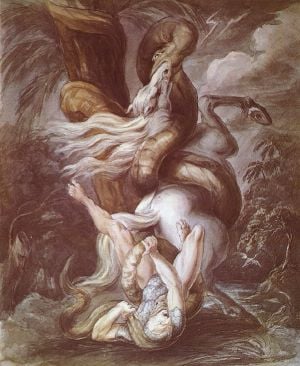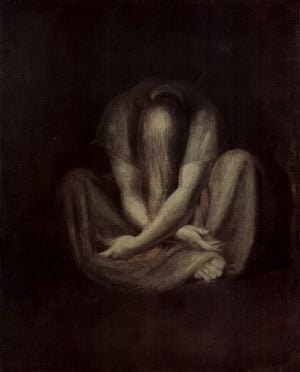Fuseli, Henry
| Line 16: | Line 16: | ||
[[Image:Johann Heinrich Füssli 059.jpg|left|thumb|''Horseman attacked by a giant snake,'' c. 1800.]] | [[Image:Johann Heinrich Füssli 059.jpg|left|thumb|''Horseman attacked by a giant snake,'' c. 1800.]] | ||
| − | After taking orders in 1761 Fuseli was forced to leave the country as a result of having helped Lavater expose an unjust magistrate, whose powerful family sought revenge. He first travelled to [[Germany]], where he had experiences in European thought, including German Enlightenment, that had a large influence on him. After a short while he obtained a transfer to England, in 1765, where he supported himself for some time by miscellaneous writing. He was also introduced to the theater, especially Shakespeare and was inspired by David Garricks' performances which anticipated, the Method, as used in modern times. Whilst on a trip to Paris Henry was to meet both Jean-Jacques Rousseau and David Hume, the philosophers who represented two poles of European thought, the skeptical romantic and the romantic skeptic. Fuseli managed to combine both as did others of his generation. | + | After taking orders in 1761 Fuseli was forced to leave the country as a result of having helped Lavater expose an unjust magistrate, whose powerful family sought revenge. He first travelled to [[Germany]], where he had experiences in European thought, including German Enlightenment, that had a large influence on him. After a short while he obtained a transfer to England, in 1765, where he supported himself for some time by miscellaneous writing. He was also introduced to the theater, especially Shakespeare and was inspired by David Garricks' performances which anticipated, the Method, as used in modern times. Whilst on a trip to Paris Henry was to meet both Jean-Jacques Rousseau and David Hume, the philosophers who represented two poles of European thought, the skeptical romantic and the romantic skeptic. Fuseli managed to combine both as did others of his generation. One face was to the past and the Enlightenment and the other to the future, Romanticism. |
Eventually, he became acquainted with [[Sir Joshua Reynolds]], to whom he showed his drawings. Following Sir Joshua's advice he devoted himself wholly to art. In 1770 he made an [[art]]-[[pilgrimage]] to [[Italy]], where he remained till 1778, changing his name from Füssli to Fuseli, because it was more Italian-sounding. | Eventually, he became acquainted with [[Sir Joshua Reynolds]], to whom he showed his drawings. Following Sir Joshua's advice he devoted himself wholly to art. In 1770 he made an [[art]]-[[pilgrimage]] to [[Italy]], where he remained till 1778, changing his name from Füssli to Fuseli, because it was more Italian-sounding. | ||
[[Image:Johann Heinrich Füssli 008.jpg|thumb|''Silence,'' 1799-1801.]] | [[Image:Johann Heinrich Füssli 008.jpg|thumb|''Silence,'' 1799-1801.]] | ||
Revision as of 12:11, 11 November 2008
Henry Fuseli (in German, Johann Heinrich Füssli; February 7, 1741 – April 16, 1825) was a British painter, draughtsman, and writer on art, of German-Swiss origin.
Biography
Biography
He was born in Zürich, Switzerland, the second of eighteen children. His father was Johann Caspar Füssli, a painter of portraits and landscapes, and author of Lives of the Helvetic Painters. His Godfather, Salomon Gessler, was a landscape artist and theorist and his fathers' friends were poets and painters. Entomology was an important family interest and brother Caspar became a professional in the field. Henry was diminutive in stature, he reached a mere five feet but his artistic and intellectual growth was rapid. Although drawing from the age of eight, his father disapproved and intended Henry for the church, sendind him to the Caroline college of Zurich, where he received an excellent classical education. One of his schoolmates there was Johann Kaspar Lavater, with whom he became close friends and seemed to be the only person to whom he could unburden himself to.
After taking orders in 1761 Fuseli was forced to leave the country as a result of having helped Lavater expose an unjust magistrate, whose powerful family sought revenge. He first travelled to Germany, where he had experiences in European thought, including German Enlightenment, that had a large influence on him. After a short while he obtained a transfer to England, in 1765, where he supported himself for some time by miscellaneous writing. He was also introduced to the theater, especially Shakespeare and was inspired by David Garricks' performances which anticipated, the Method, as used in modern times. Whilst on a trip to Paris Henry was to meet both Jean-Jacques Rousseau and David Hume, the philosophers who represented two poles of European thought, the skeptical romantic and the romantic skeptic. Fuseli managed to combine both as did others of his generation. One face was to the past and the Enlightenment and the other to the future, Romanticism. Eventually, he became acquainted with Sir Joshua Reynolds, to whom he showed his drawings. Following Sir Joshua's advice he devoted himself wholly to art. In 1770 he made an art-pilgrimage to Italy, where he remained till 1778, changing his name from Füssli to Fuseli, because it was more Italian-sounding.
Early in 1779 he returned to Britain, taking in Zürich on his way. He found a commission awaiting him from Alderman Boydell, who was then organizing his famous Shakespeare Gallery. Fuseli painted a number of pieces for Boydell, and published an English edition of Lavater's work on physiognomy. He likewise gave William Cowper some valuable assistance in preparing a translation of Homer. In 1788 Fuseli married Sophia Rawlins (originally one of his models), and he soon after became an associate of the Royal Academy. The early feminist Mary Wollstonecraft, whose portrait he had painted, planned a trip with him to Paris, but after Sophia's intervention the Fuseli's door was closed to her forever.[1] Two years later he was promoted to Academician.
In 1799 Fuseli exhibited a series of paintings from subjects furnished by the works of John Milton, with a view to forming a Milton gallery corresponding to Boydell's Shakespeare gallery. There were 47 Milton paintings, many of them very large; they were completed at intervals in the space of nine years. The exhibition, which closed in 1800, proved a commercial failure. In 1799 Fuseli was also appointed professor of painting to the Academy. Four years afterwards he was chosen as keeper, and resigned his professorship; but he resumed it in 1810, and continued to hold both offices until his death. In 1805 he brought out an edition of Pilkington's Lives of the Painters, which did little for his reputation.
Antonio Canova, when on his visit to England, was much taken with Fuseli's works, and on returning to Rome in 1817 caused him to be elected a member of the first class in the Academy of St Luke. Fuseli, after a life of uninterrupted good health, died at Putney Hill, at the advanced age of eighty-four, and was buried in the crypt of St Paul's Cathedral. He was comparatively rich at his death.
Works
As a painter, Fuseli favoured the supernatural. He pitched everything on an ideal scale, believing a certain amount of exaggeration necessary in the higher branches of historical painting. In this theory he was confirmed by the study of Michelangelo's works and the marble statues of the Monte Cavallo, which, when at Rome, he liked to contemplate in the evening, relieved against a murky sky or illuminated by lightning. The violent and intemperate action which he often displays, in the conventional wisdom, destroys the grand effect of many of his pieces. A striking illustration of this occurs in his famous picture of "Hamlet breaking from his Attendants to follow the Ghost": Hamlet, it has been said, looks as though he would burst his clothes with convulsive cramps in all his muscles.
On the other hand, his paintings are never either languid or cold. His figures are full of life and earnestness, and seem to have an object in view which they follow with intensity. Like Rubens he excelled in the art of setting his figures in motion. Though the lofty and terrible was his proper sphere, Fuseli had a fine perception of the ludicrous. The grotesque humour of his fairy scenes, especially those taken from A Midsummer-Night's Dream, is in its way not less remarkable than the poetic power of his more ambitious works.
As a colourist Fuseli has but small claims to distinction. He scorned to set a palette as most artists do; he merely dashed his tints recklessly over it. Not infrequently he used his paints in the form of a dry powder, which he hastily combined on the end of his brush with oil, or turpentine, or gold size, regardless of the quantity, and depending for accident on the general effect. This recklessness may perhaps be explained by the fact that he did not paint in oil until he was twenty-five years of age. Despite these drawbacks he possessed the elements of a great painter.
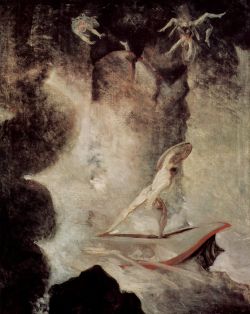
Fuseli painted more than 200 pictures, but he exhibited only a minority of them. His earliest painting represented "Joseph interpreting the Dreams of the Baker and Butler"; the first to excite particular attention was The Nightmare, exhibited in 1782. He painted two versions, shown in the Nightmare article. He also painted, about the same topic, the Hag.
His sketches or designs numbered about 800; they have admirable qualities of invention and design, and are frequently superior to his paintings. In his drawings, as in his paintings, his method included deliberately exaggerating the due proportions of the parts and throwing his figures into contorted attitudes. One technique involved setting down arbitrary points on a sheet, which then became the extreme points of the various limbs—rather like creating a constellation from the unintentional relations of stars. Notable examples of these drawings were made in concert with George Richmond when the two artists were together in Rome.
He rarely drew the figure from life, basing his art on study of the antique and Michelangelo. He produced no landscapes—"Damn Nature! she always puts me out," was his characteristic exclamation—and painted only two portraits.
His general powers of mind were large. He was a thorough master of French, Italian, English and German, and could write in all these tongues with equal facility and vigour, though he preferred German as the vehicle of his thoughts. His writings contain passages of the best art-criticism that English literature can show. The principal work is his series of Lectures in the Royal Academy, twelve in number, commenced in 1801.
Many interesting anecdotes of Fuseli, and his relations to contemporary artists, are given in his Life by John Knowles (1831). He influenced the art of Fortunato Duranti.
Time in England
In 1788 Fuseli started to write essays and reviews or the Analytical Review. With Thomas Paine, William Godwin, Joseph Priestley, Erasmus Darwin, Mary Wollstonecraft, and other men and women interested in art, literature and politics, Fuseli frequented the home of Joseph Johnson, a publisher and prominent figure in radical British political and intellectual life. When Louis XVI was executed in France in 1793, he condemned the revolution as despotic and anarchic, although he had first welcomed it as a sign of "an age pregnant with the most gigantic efforts of character." In 1799 he was appointed professor of painting at the Royal Academy, and keeper of the Academy in 1804. Among his pupils were John Constable (1776-1837), the major English landscape painter of his time, Benjamin Robert Haydon (1786-1846), William Etty (1787-1849), and Edwin Landseer (1802-73), who first exhibited at the age of twelve. William Blake, who was sixteen years his junior, recognized a debt to him, and for a time many English artists copied his mannerisms.
See also
- Füssli, Johann Caspar (1706-1782), Swiss portrait painter (Father of Henry Fuseli)
- Füssli, Johann Kaspar (1743-1786), Swiss entomologist (Brother of Henry Fuseli)
Bibliography
- Calè, Luisa. Fuseli's Milton Gallery: 'Turning readers into spectators'. Oxford: Clarendon Press, 2006.
- Keay, Carolyn. Henry Fuseli. London: Academy Editions, 1974.
- Lentzsch, Franziska, et al. Fuseli: The Wild Swiss. Zürich: Scheidegger & Spiess, 2005.
- Myrone, Martin. Gothic Nightmares: Fuseli, Blake and the Romantic Imagination. London: Tate Publishing, 2006.
- Myrone, Martin. Henry Fuseli. Princeton: Princeton University Press, 2001.
- Powell, Nicolas. Fuseli: The Nightmare. London: Allen Lane, 1973.
- Pressly, Nancy L. The Fuseli Circle in Rome: Early Romantic Art of the 1770s. New Haven: Yale Center for British Art, 1979.
- Tomory, P. A. The Life and Art of Henry Fuseli. New York: Praeger, 1972.
- Weinglass, David H. Henry Fuseli and the Engraver's Art. Boston: World Wide Books, 1982.
Notes
- ↑ Liukkonen, Petri. Henry Fuseli (1741-1825). Retrieved 2007-07-23.
ReferencesISBN links support NWE through referral fees
- This article incorporates text from the Encyclopædia Britannica Eleventh Edition, a publication now in the public domain.
External Links
Template:Mary Wollstonecraft
Credits
New World Encyclopedia writers and editors rewrote and completed the Wikipedia article in accordance with New World Encyclopedia standards. This article abides by terms of the Creative Commons CC-by-sa 3.0 License (CC-by-sa), which may be used and disseminated with proper attribution. Credit is due under the terms of this license that can reference both the New World Encyclopedia contributors and the selfless volunteer contributors of the Wikimedia Foundation. To cite this article click here for a list of acceptable citing formats.The history of earlier contributions by wikipedians is accessible to researchers here:
The history of this article since it was imported to New World Encyclopedia:
Note: Some restrictions may apply to use of individual images which are separately licensed.
